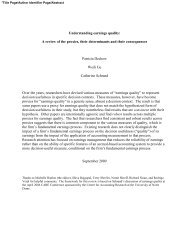Nintendo's “Revolution” - MIT Sloan School of Management
Nintendo's “Revolution” - MIT Sloan School of Management
Nintendo's “Revolution” - MIT Sloan School of Management
Create successful ePaper yourself
Turn your PDF publications into a flip-book with our unique Google optimized e-Paper software.
NINTENDO’S “REVOLUTION”<br />
Sangbeom Kim, Ian Lamont, Hiroshi Ogasawara, Mansoo Park, Hiroaki Takaoka<br />
that the company would not limit itself to playing cards, and that it would soon enter other business<br />
domains. And so it did.<br />
Surviving as a Toy Company<br />
In the early 1970s, Nintendo ventured into other businesses, including food and toys. One unexpected<br />
success in the late 1970s was Nintendo’s “Ultra Hand,” an extendable robotic arm designed by<br />
Gunpei Yokoi, an assembly line maintenance engineer working at Nintendo. Yamauchi saw that<br />
Yokoi had great ideas and engineering talent, and transferred him to product development where he<br />
came up with innovative products like a baseball throwing machine and a puzzle game. Eventually,<br />
Yokoi oversaw Nintendo’s early video game efforts, including the arcade version <strong>of</strong> Donkey Kong<br />
and the Game Boy. 45<br />
Nintendo <strong>Management</strong> Under Hiroshi Yamauchi<br />
Nintendo’s modern organizational structure was strongly influenced by the management style <strong>of</strong> the<br />
former president and CEO, Hiroshi Yamauchi, who led the company from 1950 to 2002. He was a<br />
member <strong>of</strong> the founding family. 46<br />
A charismatic leader with a strong vision <strong>of</strong> what the company could become, Yamauchi drove other<br />
family members from Nintendo’s board soon after he became president and CEO. Nintendo was<br />
originally a family-owned and -managed company but Yamauchi thought it was necessary to change<br />
its culture. 47<br />
Yamauchi was a hands-on leader, apt to make quick decisions according to his vision for the<br />
company. He was always thinking <strong>of</strong> ways in which the company could please its customers, and<br />
welcomed the introduction <strong>of</strong> new ideas, experimentation, novel processes and products — including<br />
food, toys, and, eventually, video games. This attitude extended to other companies in the Nintendo<br />
ecosystem, as one engineer later described: “Nintendo is always trying to do something new and<br />
different. This message has been spread not only within Nintendo, but to other companies as well. As<br />
a result, our development partners have naturally tended to present us with new technologies and<br />
ideas.” 48<br />
Yamauchi established a flat organizational structure at Nintendo. He wanted employees to focus on<br />
customer value, and he believed an organization free from bureaucratic rigidity was best suited to<br />
providing it. Decisions were to be made quickly. Notably, Nintendo under Yamauchi promoted a risktaking<br />
culture, which was unusual for a large Japanese company. Therefore, when Iwata became<br />
45 Lara Crigger, “Searching for Gunpei Yokoi,” The Escapist, December 25, 2007. Accessed from<br />
http://www.escapistmagazine.com/articles/view/issues/issue_129/2744-Searching-for-Gunpei-Yokoi in December 2010.<br />
46 “Nintendo History,” Nintendo.co.uk. Accessed from http://www.nintendo.co.uk/NOE/en_GB/service/nintendo_history_9911.html in June 2011.<br />
47 Takura Kura, “The Success and Failure <strong>of</strong> Nintendo,” Doushisya Business <strong>School</strong>, December 2006.<br />
48 Kou Shiota, Nintendo, “Using State-Of-The-Art Technology in Unprecedented Ways,” Wii.nintendo-europe.com, December 2006. Accessed from<br />
http://wii.nintendo-europe.com/163.html in December 2010.<br />
October 18, 2011 10
















